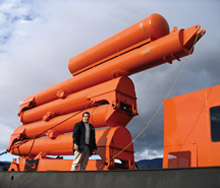Directory:NewsUSA/Articles/Giant Robotic Arm Performs Underwater Work
Giant Robotic Arm Performs Underwater Work
<adsense> google_ad_client = "pub-5512298628457000"; google_ad_width = 728; google_ad_height = 90; google_ad_format = "728x90_as"; google_ad_type = "text_image"; google_ad_channel = ""; google_color_border = "FFFFFF"; google_color_bg = "FFFFFF"; google_color_link = "0066CC"; google_color_text = "000000"; google_color_url = "008000"; </adsense>
(NewsUSA) - Imagine reaching your hand into the Gulf of Mexico, down into the water hundreds of feet, and scraping your fingers along the seabed. Now imagine lifting something up that weighs thousands of pounds as if it were only a pebble. No, it's not the latest science-fiction movie or a reworking of Jack and the Beanstalk, it's a new technology that's changing the face of underwater work and construction.
Typically, human divers perform jobs such as assisting with the construction of offshore rigs or cleaning debris from the bottom of polluted waterways. But these jobs regularly involve shifting heavy pieces of equipment or working in potentially toxic waters, jobs that are both dangerous and difficult for divers to perform. But one company has set out to make underwater work safer, faster and easier than ever before.
Aquatic Cellulose (pending name change to The Valor Corp.) has recently completed first-phase construction on the Tiger-Lynk-120, an advanced hydraulic manipulator that company officials say could be the largest in the world. Tiger-Lynk is a patented system of technologies that enables an operator to target, drill, cut, weld and manipulate large objects at depths up to 400 feet, providing a 360-degree range of movement inside a space one-third the size of a football field. It features a 120-foot-long hydraulic arm that weighs more than 35,000 pounds and can lift over 5,100 pounds. A barge or a rig usually acts as a platform for the arm, which is controlled by an operator from inside a control room. Using Tiger-View, Aquatic Cellulose's innovative vision enhancement system, the operator sees everything underwater, even in the murkiest conditions.
According to Aquatic Cellulose, the technology has been tested and proven in the recovery of underwater Amazon rain forests and now has the flexibility to target multiple industries, many of which have eco-friendly benefits.
The sheer size and articulation of Tiger-Lynk could allow companies to repair damaged offshore oil rigs more quickly and efficiently, thus saving critical time and money while reducing the chances of environmentally harmful spills and leaks. It also could be used to clean toxic waste or remove large debris from canals, lakes, rivers or other large bodies of water.
The Tiger-Lynk-120 is scheduled for production this spring and will be available for both sale and lease to a variety of industries, including oil and gas, timber and civil engineering. For more information, visit www.valorenergy.com. Aquatic Cellulose currently trades under the symbol AQCI on the OTCBB.
<adsense>
google_ad_client = "pub-5512298628457000";
google_ad_width = 728;
google_ad_height = 90;
google_ad_format = "728x90_as";
google_ad_type = "text_image";
google_ad_channel = "";
google_color_border = "FFFFFF";
google_color_bg = "FFFFFF";
google_color_link = "0066CC";
google_color_text = "000000";
google_color_url = "008000";
</adsense>
seabed
offshore rigs
polluted waterways
underwater work
robotic arm
gulf of mexico
